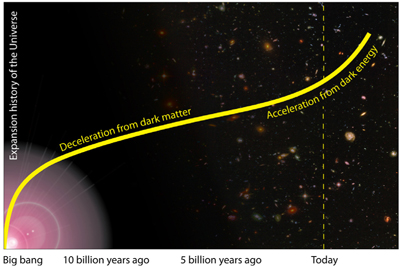What is dark energy?
Dark energy is an unidentified component of the Universe that is thought to be present in such a large quantity that it overwhelms all other components of matter and energy put together. According to the most recent estimates from ESA's Planck mission, dark energy contributes 68 percent of the matter-energy density of the Universe.
One way to envisage the dark energy is that it seems to be linked to the vacuum of space. In other words it is an intrinsic property of the vacuum. So, the larger the volume of space, the more vacuum energy (dark energy) is present and the greater its effects.
The evidence for dark energy came to light in the late-1990s from observations of supernovae. These exploding stars are extremely bright and can be seen across large swathes of the cosmos. By searching for a specific type of supernova, known as supernova Ia, which all explode with about the same amount of energy, astronomers can use them to gauge cosmological distances and thus calculate how fast the Universe has been expanding in the past compared to now.
This work was expected to show that the expansion was slowing down because it was being resisted by the gravity of all the Universe's celestial objects. In 1988, American astronomer Saul Perlmutter launched a group to make these measurements, called The Supernova Cosmology Project. They were joined in 1994 by an independent group called The High-z Supernova Search Team, led by American Australian astronomer Brian Schmidt and in which American astronomer Adam Riess played a crucial role.
By 1998, the two teams had their results and instead of the expected deceleration, both had found that the expansion was accelerating. This was completely unexpected because nothing in known physics was capable of producing this effect. In keeping with the naming of the mysterious dark matter, astronomers began referring to whatever was causing the acceleration as dark energy.
 |
|
Expansion history of the Universe. Credit: Euclid Assessment Study Report |
Now almost a quarter of a century after its discovery, understanding the acceleration remains one of the most compelling challenges of cosmology and fundamental physics. The precise nature of dark energy continues to remain mysterious. The best working hypothesis is something that Albert Einstein suggested back in 1917. Shortly after he published the General Theory of Relativity, his description of the gravity and the Universe on its largest scales, Einstein introduced the 'cosmological constant' into his calculations.
The cosmological constant is an energy field that is present across the entire Universe, in technical terms it is called a scalar field. Einstein initially introduced it to resist the pull of gravity from all the celestial objects and hold the Universe stable and unmoving. However, the discovery that the Universe was expanding rendered Einstein's use of the cosmological constant redundant. He struck it from his equations and is even reported to have called it his biggest 'blunder'.
Now cosmologists have re-introduced the cosmological constant because it could be the simplest way to explain the observations. There are alternative suggestions. For example, the acceleration could be produced by a new force of nature or due to a misunderstanding of the way General Relativity works. Each explanation subtly alters the way the acceleration develops across cosmic time but as yet no experiment has been capable of measuring the acceleration in sufficient detail to distinguish between the possible solutions.
Euclid is different. It has been designed to reach unprecedented levels of observational accuracy. This will allow it to precisely map the distribution of galaxies over the last 10 billion years of cosmic history. In so doing, it will finally reveal the precise way dark energy has accelerated the Universe, and allow astronomers to distinguish between a cosmological constant and many of the alternatives. For example, the Euclid mission is required to measure the variation of the cosmic acceleration – the so-called "jerk" – to an accuracy of better than 10 percent. This will show whether the cosmological constant is indeed constant. If it is not, then the lambda-CDM model cannot work and will need replacing.
Beyond even this, the evolution of cosmic structures can directly test general relativity itself. Euclid will measure "gamma", the index of structure growth, to within an accuracy of 2 percent. If this test fails then general relativity does not hold on cosmological scales, and will need replacing with a deeper theory. So again, Lambda-CDM can't be true and cosmologists will have to look for new physics to match the Euclid results.
| Read more |
| 1: Mission science |
| 2: What is dark matter? |
| 3: What is dark energy? |
| 4: What is gravitational lensing? |
| 5: What are baryonic acoustic oscillations? |
| 6: Legacy science (beyond cosmology) |
